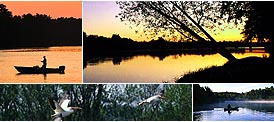
| Redfish | Sailfish | Sharks | Sheepshead | Snapper | Snook | Spanish Mackerel | Spotted Seatrout | Tarpon |

SPANISH MACKEREL
Regulations
12" minimum size limit; no closed season; 10 per person per day limit
General Information
This species is highly migratory. In general, schools of fish move northward along the Atlantic and Gulf Coast in the spring and make the return trip south in the fall. An open water species, Spanish mackerel spawn offshore of Florida beginning in April.
Distribution
This species is caught somewhere in Florida every month of the year. Year round action occurs in extreme south Florida including the Keys. In the spring the migration begins and anglers along both coasts start seeing the fish show up as the ocean waters warm up. The schools of mackerel follow the warming trend and by June are commonly caught in the northern Gulf of Mexico and off the Jacksonville coast.. There will remain here, especially in the Gulf, until the fall when the first cold fronts send the fish south for the winter.
With mackerel being migratory and swimming in schools, anglers may find them around in huge numbers one day and nearly gone a day or two later. You can catch this species from the surf, off ocean piers and from a boat anywhere from inside the passes to a mile or two of shore along the Atlantic coast or five miles offshore along the Gulf of Mexico coast.
Tackle and Techniques
Medium duty spinning or bait casting tackle with 6-12 pound test line is suitable. Use a heavy monofilament leader or a small diameter wire leader. This fish has a mouthful of small sharp teeth that can cut a monofilament leader.
A good way to locate the schools of fish is to look for birds such as pelicans and terns. If you see groups of them working a small area it's a good indication that they are feeding on a school of baitfish. In the absence of the birds, look for a large patch of disturbed water. That's also an indication of the baitfish. If mackerel are around it's a good bet that they will be under the baitfish and feeding on them.
Another way to locate schools of fish is to troll with a spoon or jig. Even at a slow speed you can cover a lot of water in a short period of time. Eventually you will find some fish if they are in the area. When you hook the first fish continue to work the area. Being a schooling species there will be more than one fish around.
Bait
Spanish mackerel like live shrimp or baitfish. Hook the bait and free-line it in the water column. For trolling or casting a spoon or jigs work best. If you see the fish but they don't seem to be hungry try changing to a smaller sized bait or lure.
Secrets to Success
* This species segregates itself by size. When you encounter a congregation of trout, chances are real good they will all be within an inch or two of each other. If they are too small, move on and look for the bigger ones.












